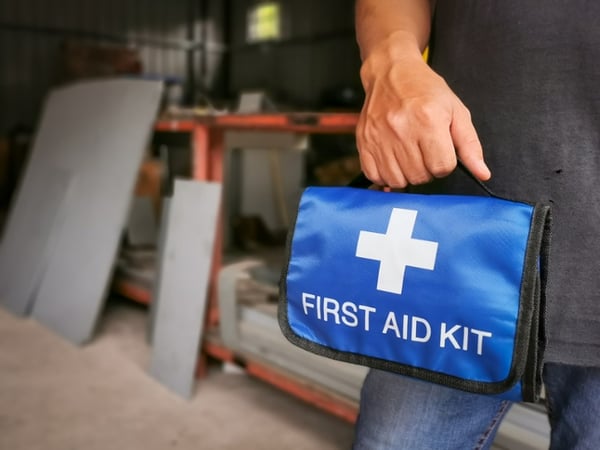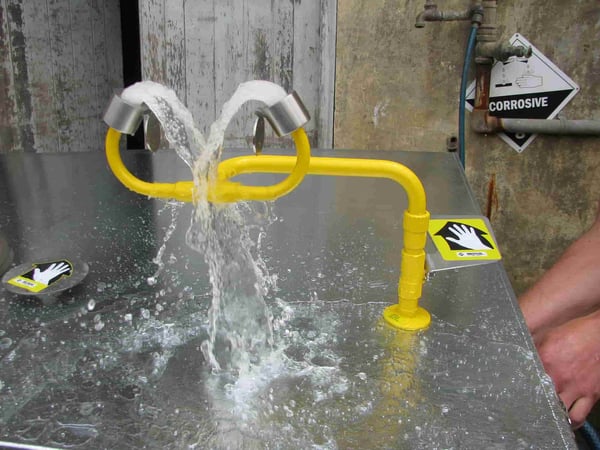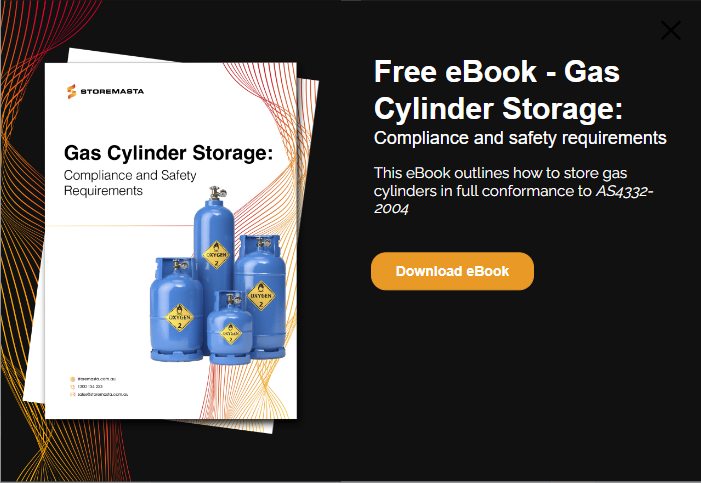First aid is essential in every workplace, but that necessity only intensifies when you’re working with any type of dangerous goods. In this post, we’ll be looking at the first aid procedures and requirements for organisations who are working with gas cylinders. By understanding all the safety measures needed for your organisation — from first aid kit requirements to safety showers — you can help your staff stay safe.
REMEMBER: If your worksite stores and handles gas cylinders you’ll need to ensure your work methods and safety equipment meet the guidelines of AS 4332 - The storage and handling of gases in cylinders. The Standard includes all requirements including provision for first aid equipment, procedures and training for responding to dangerous incidents and chemical emergencies involving compressed gases.
Necessary First Aid Equipment For Gas Cylinders
Whether you’re handling gas cylinders of oxygen, LPG or acetylene, the first aid requirements for your worksite are an important safety and compliance issue that you need to get right.
While compressed gases in cylinder fall into the Class 2 dangerous goods classification, each division of gases poses its own unique hazards and threats to human health. That’s why it’s so important to refer to the Australian Standard AS 4332 as well as the individual safety data sheets for each gas kept onsite.
Some common health issues caused by Class 2 gases may include:
- Asphyxiation
- Cold burns
- Toxic poisoning
- Fire or explosion
- Dizziness or nausea
- Impact injuries due to handling of gas cylinders
IMPORTANT: Like to learn more about the hazards associated with compressed gases in cylinders? Read our popular post Risks Associated with the Different Classes of Dangerous Gases.
First Aid Kits and First Aid Rooms
Adequate first aid provisions must be provided in a clean area of the workplace. A good idea is to set up a dedicated first aid room or first aid station that is well-lit and easily accessible with clear signage.
The first aid station must contain a first aid kit that’s equipped to handle exposure to the compressed gases stored or handled nearby. There must also be first aid instructions and copies of the safety data sheets (SDS) for each of the gases held on the premises.

Your first aid requirements will be determined by your onsite needs and the safety data sheets of your gas cylinders.
When creating your first aid station always consult each of the safety data sheets, then adopt the first aid procedures outlined in the document. First aid kit requirements in the workplace are not only a compliance consideration, but an essential safety precaution that could save the lives of your team members.
REMEMBER: A risk assessment can help you determine all the safety measures required for your workplace. Whether you’re working with gas cylinders or other hazardous chemicals, we recommend conducting a risk assessment to determine your gas cylinder storage, handling and first aid needs.
Example of First Aid for Gas Cylinders
As an example, let’s consider that you’re using sulphur dioxide gas at your worksite. To determine the first aid measures, you would check the safety data sheet provided by the supplier and follow the guidelines in Section 4: First Aid Measures.
The safety data sheet for Sulphur Dioxide advises that contaminated skin must be flushed with plenty of water and clothing should be removed. Contaminated clothing, however, must be washed thoroughly with water before removing. First aiders should wear gloves and continue to wash the skin for at least 10 minutes after the clothing is removed.
From this information your first aid kit might contain:
- Protective gloves for first aiders
- Scissors capable of quickly cutting away contaminated clothing
- Waste bags to contain the contaminated clothing
- CPR mask or face shield in case mouth-to-mouth resuscitation is necessary
Remember that first aiders require specific training about the chemical properties of the gases and how to treat a workmate (or themselves) without compromising their own safety.
REMEMBER: This is a generic example only. You must always check the safety data sheet (SDS) provided by the supplier for the specific gas or chemical you are using. Chemical properties, toxicology and hazard intensity of a substance can vary between manufacturers.
Safety Showers and Eye Wash Stations
Section 5.5.2 of the Standard outlines a provision for a safety shower (or plunge bath) and eye wash facilities to be installed at a worksite if toxic, corrosive or cryogenic gases are present. The first 10-15 seconds after exposure to toxic substances (especially corrosives) is critical for flushing away toxins and preventing permanent impairments or even death.
The need for emergency showers and eyewash stations will be determined by the chemical properties of the gases and how they are used at your workplace. A job hazard analysis can be undertaken to evaluate the potential hazards of both the job methodology and the work area.
REMEMBER: Safety showers and eye wash stations serve different purposes, though combination units are available to suit a range of industrial workplaces. Combination units are effective if the worker has had their full body (including the eyes) exposed to the gas.
Safety Showers
Safety showers are designed to flush away contaminants from the user's head and body. They are not suitable for flushing someone’s eyes because water pressure could cause additional damage. Eye wash stations are specifically designed to deliver a safe flow of water to both eyes at the same time and should be used instead.
Choose a safety shower that can be activated quickly (with a single hand action or foot lever) and the water continues to flow even if the operator’s hand or foot is removed from the lever. The diameter of the shower head should also be wide enough to ensure the water will contact the entire body.
Eyewash Stations
Eyewash stations flush clean water directly to the eyes and face and should be able to wash both eyes simultaneously. Look for an eye wash station with the same operational features outlined for safety showers (above) plus enough space to enable the operator to open their eyelids with their hands and still have water flushing into both their eyes.
The best eyewash stations have an automatic pressure compensating valve to ensure a safe and steady flow of water under varying water supply conditions, as well as a filter in the spray head to protect users against particles in the water.
Eyewash stations must operate with both eyes being flushed at the same time.
Drench Hoses
Hand-held drench hoses can be used when a full shower isn’t required or if the victim is unconscious or unable to stand.
IMPORTANT: Safety showers and eye wash facilities should comply with AS 4775.
First Aid Procedures and Training
First aid equipment is useless if no-one onsite knows where it is or how to use it. The Standard clearly states that your organisation requires clear first aid procedures developed from the gas cylinder safety data sheets. Staff must also receive adequate training so first aid procedures are effective. Training should include information on the first aid measures, as well as how to use the equipment and where to locate the first aid kit and emergency decontamination equipment.
IMPORTANT: Staff should also be retrained at regular intervals to ensure that they maintain adequate first aid skills and safety knowledge.
Gas Cylinder First Aid
This blog has outlined the first aid requirements of AS 4332 - The storage and handling of gases in cylinders. For a more detailed look at gas cylinder safety, why not download our eBook Gas Cylinder Storage: Compliance and safety requirements? It’s written in a clear, easy-to-read format and contains real world examples and case studies. The guide covers essential information including regulations, requirements and gas cylinder storage. Get your copy now to learn more.
Joining the team as a Dangerous Goods Storage Consultant, Melissa Hampton became Storemasta's Marketing Manager in late 2021. With extensive knowledge and experience in chemical compliance, Melissa is responsible for leading the Marketing team and helping shape their marketing strategy. In her spare time, you can find Melissa hiking, swimming and enjoying the great outdoors in beautiful north-west Tasmania.

